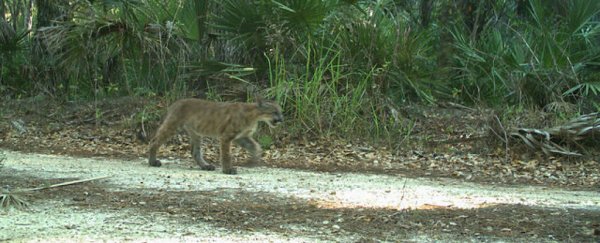For the first time since 1973, endangered panther kittens have been spotted north of Florida's Caloosahatchee River - evidence that despite all odds, these big cats are actually expanding their range.
Until now, only male panthers have been spotted north of the river, and for decades it was assumed that the females refused or were unable to cross it. But new images of healthy kittens have revealed that the Florida panther population could still be maintaining its unlikely increase.
"Until now, we had only evidence of panthers breeding south of the Caloosahatchee," Kipp Frohlich from the Florida Fish and Wildlife Conservation Commission's (FWC) Division of Habitat and Species Conservation said in a statement.
"These pictures of a female with kittens indicate that there are now panthers breeding north of the river."
 A panther kitten following its mother on March 18. Credit: FWC
A panther kitten following its mother on March 18. Credit: FWC
 The mother, spotted seconds before the kitten on March 18. Credit: FWC
The mother, spotted seconds before the kitten on March 18. Credit: FWC
Florida panthers are a critically endangered subspecies of cougar that have made their homes in the forests and swamps in the southern half of the state.
Once common throughout the southeastern US, the subspecies hit its lowest point in the 1970s, when just 20 individuals were estimated to be left in the wild.
A breeding experiment in 1995 saw eight female cougars brought over from Texas to give the dwindling gene pool a kick, and the cats managed to increase their population to around 200 by 2014.
Despite now being restricted to less than 5 percent of their historic range, and still faced with considerable threats, including poaching, busy roads, disease, and pollution, conservationists are extremely encouraged by this latest sighting.
"This is good news for panther recovery," Larry Williams from the US Fish and Wildlife Service said in a press statement.
"The service is committed to working with landowners to make panthers and private land ownership compatible."
Back in November 2016, Florida conservation officials announced that they'd seen a female panther finally cross the Caloosahatchee River for the first time in decades.
It's not clear how many have followed suit since then, but experts say this is the single best thing the big cats could have done to ensure the survival of the subspecies.
In fact, these pioneering females appear to have done the Florida Fish and Wildlife Conservation Commission a favour - for decades now, the government has had a long-term recovery plan in place for the subspecies, the primary goal of which was to:
"[M]aintain, restore, and expand the panther population and its habitat in south Florida, and expand the breeding portion of the population in south Florida to areas north of the Caloosahatchee River."
Looks like the panthers have done their job for them.
It's no time to get complacent about the fate of these important big cats - they're still critically endangered, after all - but it's refreshing to finally have some good news amid sobering predictions from scientists that a "major extinction event" could be on the cards for primates if things don't change.
Let's hope the Florida panther continues to defy all odds by finding new ways to survive out there in the sunshine state.
"For many years, the Caloosahatchee River has appeared to be a major obstacle to northward movement for female panthers," says Darrell Land, the FWC panther team leader.
"This verification of kittens with the female demonstrates panthers can expand their breeding territory across the river naturally."
